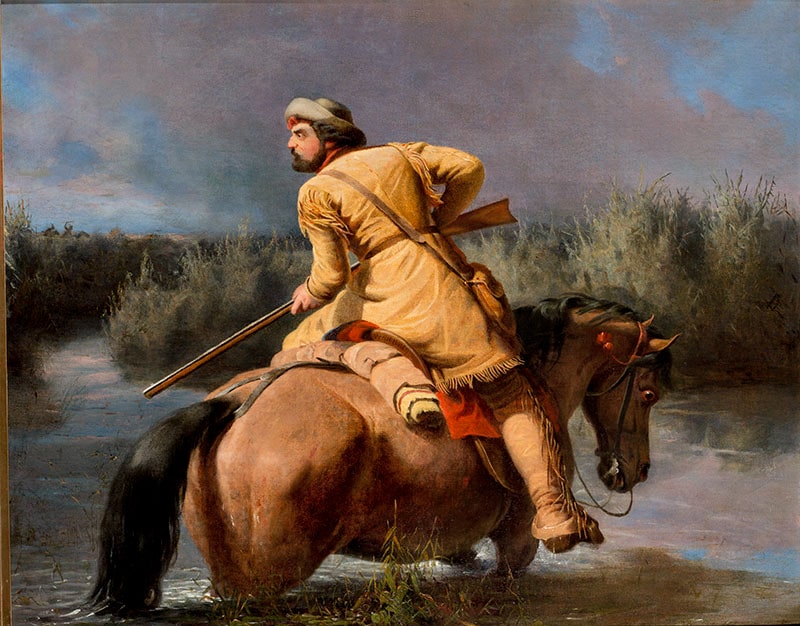Inspired by Actual Events
William Tylee Ranney, The Last Shot (Trapper’s Last Shot), c. 1850.
Background Information
Many of our nation’s first storytellers came in the form of artists. Some of these artists traveled west with teams of surveyors and explorers and shared their experiences through art. Other artists retold dramatic stories from the frontier, shaping Americans’ perceptions and imaginations of the West. These images would, for generations, create the sense that the West was full of adventure.
In this painting, the artist is retelling a dramatic true event. According to the tale, a trapper was making his way through rushing river waters, when he was spotted by a group of Native Americans. With nowhere to hide, what do you think might have happened to him?
Look Closer

Take a look at the figure’s facial expression and pose.
Observe his surroundings,
and the changing weather.
Follow the Trapper’s gaze to identify the impending danger.
Notice how the artist has used the trapper’s horse and its position in the water to emphasize his perilous situation.
William Tylee Ranney, The Last Shot (Trapper’s Last Shot), c. 1850.
In the medium of paint, artists can only capture a moment in time—only a piece of the story. Artists make choices to emphasize certain parts of the story, and leave out other details that may not help get their point across. Observe the painting closely and consider what part of the story the artist may be representing. Take a look at the figure’s facial expression and pose1. Observe his surroundings2, and the changing weather3. Follow the Trapper’s gaze to identify the impending danger4. Notice how the artist has used the trapper’s horse and its position in the water to emphasize his perilous situation5.
Discussion Questions
- What event do you think the artist is representing here?
- Do you think it’s the beginning, middle, or end of the story? Why?
- What do you think may have happened right before this scene? What do you think will happen next?
- What details do you notice that the artist might use to help tell the story?
- What does the artist emphasize in this painting?
- How does the artist help you to connect to the story he is retelling through this painting?
Activity
What exciting event has happened to you, or someone you know, recently? Use the worksheet attached to describe your story. Include characters, and describe the beginning, middle, and end. If it helps, highlight the main character(s) and make note of each part of the story. Then, draw a picture that depicts all or part of the event. Are there particular details you emphasized? What did you leave out of the drawing?
Materials:
Beginning, middle, and end worksheet
Pencils
Highlighter
Colored pencils/crayons/markers/watercolors
Grade levels: P-12 CO Standards
Visual Arts (2020)
Preschool: 1.1 ; 2.1 ; 3.1 ; 4.1
Kindergarten: 1.1 ; 2.1 ; 3.1 ; 4.1
1st Grade: 1.1 ; 2.1 ; 3.1 ; 4.1
2nd Grade: 1.1 ; 2.1 ; 3.1 ; 4.1
3rd Grade: 1.1 ; 2.1-2 ; 3.1 ; 4.1
4th Grade: 1.1-2 ; 2.1-2 ; 3.1-2 ; 4.1
5th Grade: 1.1-2 ; 2.1-2 ; 3.1-2
6th Grade: 1.1-3 ; 2.1-3 ; 3.1-3 ; 4.1-3
7th Grade: 1.1-3 ; 2.1-2 ; 3.1-3 ; 4.1-3
8th Grade: 1.1-3 ; 2.1-2 ; 3.1-3 ; 4.1-3
High School: 1.1-3 ; 2.1-3 ; 3.1-3 ; 4.1-3
Reading, Writing and Communicating (2020)
Preschool: 1.1-2 ; 2.1 ; 3.1 ; 4.1
Kindergarten: 1.1-2 ; 3.1,3,4
1st Grade: 1.1-2 ; 3.3-4
2nd Grade: 1.1-2 ; 3.3-4
3rd Grade: 1.1-2 ; 3.3-4
4th Grade: 1.1-2 ; 3.3-4
5th Grade: 1.1-2 ; 3.3-4
6th Grade: 1.1-2 ; 3.3-4
7th Grade: 1.1 ; 3.3-4
8th Grade: 1.1 ; 3.3-4
9th/10th Grade: 1.1 ; 3.3-4
11th/12th Grade: 1.1 ; 3.3-4
Resources



